
GO FOR WHOLE GRAINS
CHOOSE WHOLE, AND YOU WON’T FEEL HALF-FULL.
THE ERA OF CARB PHOBIA IS PASSING, and public taste is rebounding toward simpler foods. Whole grains are definitely back in the spotlight, the soul of the health-food ideal. Today’s “it” food is one of mankind’s oldest foods—only in the last century, in fact, have refined grains become more popular than whole grains, thanks to the introduction of white flour at the industrial level.
When left whole, grains are full of protein, fiber, complex carbohydrates, vitamins, and antioxidants, many of which are stripped away during the refining process. A diet rich in whole grains is associated with a lower risk of heart disease, stroke, and type 2 diabetes, and whole grains in the diet seem to help with weight control.
Problem is, getting whole grains into a modern diet isn’t simple at all. Only half of you say you’re regularly eating three servings of whole grains a day, and no wonder: The whole-grain landscape is confusing. There is no simple standard for a serving. Food labels are unreliable. Definitions are tricky. The goal of this habit is to help you figure out the maze of information by taking a simple approach to servings, decoding the labels, and then getting three servings of whole grains into your diet each day, without a lot of fuss. It can be as simple as having a serving at breakfast, lunch, and snack time or dinner.
YOUR GOAL
Eat three servings of whole grains each day.
The 12 healthy habits

SOMETIMES JUST A LITTLE SWITCH in meals or snacks or the ingredients you typically use can translate into huge gains for your whole-grain goals.
WHEN MAKING SANDWICHES...
Use whole-wheat bread, pitas, or tortillas. All count as up to two of your three recommended daily servings of whole grain. Typically, two slices of whole-wheat bread contain fewer calories and a bit more fiber than one whole-wheat pita, which has less sodium. Just check the label to make sure it says 100% whole wheat.
WHEN BAKING...
Sub half of your all-purpose flour with whole-wheat flour. But don’t just dive into your favorite recipes for muffins, breads, and cookies and replace all the flour with whole-wheat. There are definite texture and flavor differences. Starting out, you may seek recipes using a mix of flours to get your palate used to the differences.
WHEN BUYING CEREAL...
Make sure you see the words “whole grain” as the first ingredient, such as whole-wheat, whole oats, or whole corn. Instant oatmeal is also a quick and easy choice (just make sure sugar and salt aren’t also listed as top ingredients).
Opt for the whole-grain variety. There are also brown rice, Kamut berries, rye, spelt, or pastas that you can try to add variety. Their flavor can range from slight to very pronounced, so plan to serve with bold-flavored sauces, such as a garlicky-herby marinara or a robust mushroom sauce.
WHEN SNACKING...
Go for popcorn instead of pretzels. Three cups of air-popped popcorn count as a fiber-rich whole-grain serving. If choosing the bagged variety, read the ingredient list: Many of the brand names have added salt, butter, and sugar.

When buying cereal, check that “whole” or “whole grain” appear before the grain’s name.
MAKE YOUR SNACKS WHOLE.
Spread peanut butter on a slice of whole-wheat bread and top with sliced banana and almonds.

Air-popped popcorn has less than half a gram of saturated fat in 3 satisfying cups, and you enjoy a whole-grain serving rich in fiber. The 94% fat-free microwave popcorns are nearly as good.
THE DISH ON WHOLE GRAINS
Here are four reasons why enjoying more whole-grain foods can helpkeep you healthy and trim.
1. It lowers risk of heart disease. In a 2008 meta-analysis, which compiles data from several studies, researchers concluded that whole-grain consumption not only made heart disease less likely, but less serious if it does occur.
2. It reduces risk of insulin resistance and metabolic syndrome. Research from the Harvard School of Public Health has found that three or more servings of whole grains daily reduces your risk of developing these two precursors to type 2 diabetes.
3. It lowers chances of colon cancer. It may cut your risk by about 20%, according to a meta-analysis published in the British Medical Journal.
4. It helps you stay at a healthy weight. Women who consume more whole grains weigh less than those who don’t, according to the Harvard Nurses’ Health Study, which tracks the healthof thousands of nurses.
EXPERT TIP: Get Started Early

“If you don’t get your whole grains at breakfast, your odds of eating at least three servings go down as the day goes on. You may think that you’re getting fiber in other ways, like fruits and vegetables, but studies indicate that grain fiber is the most protective of our health. It may take a little planning, and eating more often at home, but it’s not that difficult to do.”
—Joanne Slavin, PhD, RD, professor in the Department of Food Science and Nutrition, University of Minnesota
UPPING YOUR WHOLE-GRAIN INTAKE becomes a whole lot easier when you add whole grains to some of your best-loved meals.
AT BREAKFAST...
▪ Stir a handful of rolled oats, wheat berries, or whole-grain granola into your yogurt.
▪ Toss toasted amaranth seeds into the batter for pancakes, muffins, and breads.
▪ Use last night’s leftover quinoa or bulgur as a base for hot cereal. Reheat and top with cinnamon, brown sugar, or any of the toppings.
AT LUNCH...
▪ Use wheat berries, spelt, or millet for a pasta-like salad with chopped veggies and fresh herbs, like Wheat Berry Salad with Raisins and Pistachios.
▪ Add brown rice or barley to homemade or canned soup.
▪ Go for 100% whole-wheat flour tortillas when making quesadillas, tacos, and chips.
AT DINNER...
▪ Stir bulgur or oats into ground beef or turkey when making meatballs, burgers, or meat loaf.
▪ Toss a cup of wheat berries or wild rice into your favorite slow-cooker chili.
▪ Serve entrées (like chicken in a sauce or braised meat) on top of brown rice, whole-wheat noodles, or whole-grain polenta.

Stirring bulgur or oats into ground beef or poultry helps keep the mixture moist.

“I don’t really pay attention to whole grains, but this is a chance to get healthier.”
L’ANNE GILMAN
Gallery Owner
 WHOLE-GRAIN CHALLENGE: L’Anne loves to cook, but she worries that her heavy Southern cooking—fried chicken, dumplings, and meat loaf—will eventually take its toll on her health. She also wants to set a healthier example for her three kids.
WHOLE-GRAIN CHALLENGE: L’Anne loves to cook, but she worries that her heavy Southern cooking—fried chicken, dumplings, and meat loaf—will eventually take its toll on her health. She also wants to set a healthier example for her three kids.
OUR ADVICE
▪ Find a whole-grain baking mix. There are a variety of whole-grain baking mixes out there for convenient pancakes, biscuits, even chicken and dumplings. Look in your supermarket, or buy online.
▪ Add whole grains gradually. You don’t have to go whole-hog right away—it might backfire with picky eaters. Try a combo of half regular pasta with half whole-wheat at first to help your family gradually adjust to the differences in taste and texture.
▪ Use whole-wheat breadcrumbs. Pulse 100% whole-wheat bread in a food processor to make breadcrumbs (1 slice will produce about ½ cup crumbs). Use as breading for chicken cutlets, a binder for meat loaf, or a topping for casseroles like mac and cheese. To complement the nutty flavor (or mask it, if some don’t enjoy it), toss with olive oil, garlic, and herbs.
▪ Use whole-wheat flour in cookies, muffins, and breads. But start with half all-purpose flour and half whole-wheat flour since whole-wheat flour affects texture and flavor.

Top casseroles and mac and cheese with whole-wheat breadcrumbs.
A GRAIN IS A SEED, WITH THREE PARTS: the germ, the endosperm, and the bran. Refined grains consist of only one part of the seed: the starchy endosperm, which lacks some valuable nutrients.
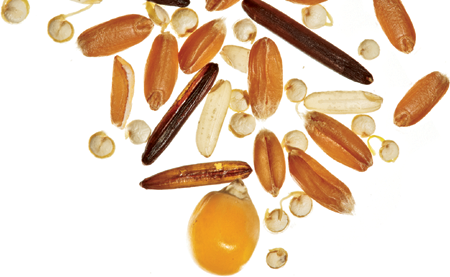
Germ: The inner embryo of the grain is the nutrient storehouse and sprouts into a new plant when fertilized by pollen.
Provides: healthy fats, vitamin E, B vitamins, phytonutrients, and minerals
Endosperm: The starchy, thick middle layer serves as the energy supply for the growing plant.
Provides: protein and carbohydrates
Bran: The tough outer shell helps protect the other two parts of the kernel from assault by sunlight, pests, water, and disease.
Provides: antioxidants, fiber, B vitamins, and minerals
COUNTING ON WHOLE GRAINS
Certain foods are always whole grain, such as oatmeal, brown rice, and quinoa, while others are sometimes whole grain depending on how they’ve been processed. It gets even trickier when it comes to breads, cereals, crackers, and other processed grain foods. Many of these products contain a mixture of whole and refined grains.
A product can only be called “whole grain” if it includes at least 51% whole-grain ingredients or 8 grams of whole grains per serving. A full serving is 16 grams of whole grains, which is the amount you’ll find in foods labeled 100% whole-grain or those that list whole wheat or another whole grain as the first ingredient.
Keep in mind that a serving of grains may not be equal to a serving of whole grains. You need 16 grams of whole grains before it’s a full serving of the good stuff. For instance, a cracker that touts “made with whole grains” may provide only 5 grams of whole grain per serving, which means you’d need to eat more than 3 servings, or 48 crackers (more than 200 calories), to get a single whole-grain serving. That’s why checking the ingredient list isso important.
Focus on 48: The daily goal is 48 grams of whole grains, or three servings that each provide 16 grams of whole-grain ingredients.

The Whole-Grain Seeker on a Budget
“I’m confused about what I’m getting—or not getting—when I read labels.”
ADAM HICKMAN
Cooking Light Recipe Developer
 WHOLE-GRAIN CHALLENGE: “I eat raisin bran and feel proud, but I’m not even sure it’s whole grain,” says Adam. “I need help translating what the marketing people put on packages. Whole grains can be expensive, and I want to make sure what I’m buying is genuine, and that I’m eating the right amount of it.”
WHOLE-GRAIN CHALLENGE: “I eat raisin bran and feel proud, but I’m not even sure it’s whole grain,” says Adam. “I need help translating what the marketing people put on packages. Whole grains can be expensive, and I want to make sure what I’m buying is genuine, and that I’m eating the right amount of it.”
OUR ADVICE
▪ Read front-of-box claims. Look for “100% whole grain” or “whole grain.” The 100% claim means all grains in the product are whole, and you’ll get at least 16 grams per serving. Labeling, particularly for products that say “made with whole grains” can be confusing.
▪ Look for other claims and stamps. If you see a claim or stamp (like the Whole Grains Council stamp), use this as a starting point. Still check for “100% whole-wheat” or “whole grain,” and avoid products with a long list ofingredients. Also know that the absence of a stamp doesn’t mean much: It’s a voluntary program, so not every whole-grain product will have the WGC stamp.
▪ Study the ingredient list. If the product lists “100% whole-wheat” or “whole-grain” wheat, corn, or other whole grain first, you’ve found the real thing.

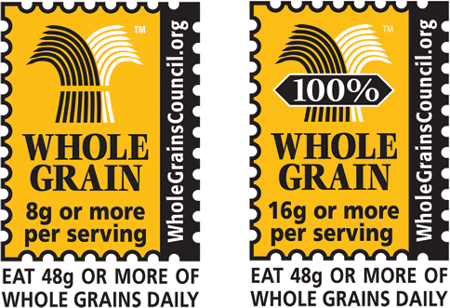
Avoid the Imposters: What Isn’t a Whole Grain
WALK THROUGH ANY SUPERMARKET and you’ll find an array of whole-grain and health claims on packages. But how can you tell if a product is really a whole-grain food? Here are foods that might seem to be whole grains—but really aren’t.

Degermination involves the removal of the oil-rich and vitamin-packed germ from the whole grain. It yields a more shelf-stable product, which is desirable for food manufacturers but not for your whole-grain goals.
B. GRITS
Most commercial quick-cooking grits are made from white hominy, which is a form of corn that has had the hull and germ removed, and therefore is not a whole grain. Though often difficult to find, whole-grain grits are slowly becoming more widely available, especially from local stone-grinding mills. Just remember: If the grits are made from hominy, they’re not a true whole grain.
C. UNBLEACHED OR ENRICHED FLOUR
While both the unbleached and enriched aspects of flour are good qualities, they do not indicate a whole grain. Unbleached flour is allowed to “bleach” naturally with age, while bleached flour is chemically treated to speed up the whitening process. Enriched flour is nutritionally enhanced with B vitamins, iron, and folic acid.
D. WHEAT GERM
While this is a great source of B vitamins, minerals, healthy fats, and protein, wheat germ is not a true whole grain. As the name imparts, the germ stands alone, in its unnatural state without the bran and endosperm. For bonus nutrition, use this product as a healthy addition—but not a substitution for—whole-grain breads, muffins, cereals, and cookies.
E. PEARLED BARLEY
Though extremely healthy and full of fiber, when barley is “pearled” it canno longer claim itself as a whole grain, as most of the bran has been stripped from the grain.
F. WHEAT BRAN OR G. OAT BRAN
They’re a high-fiber option, but are not whole grains—the bran has been stripped from the germ and endosperm. Don’t scratch this choice off your grocery list, though: You can mix either type into a 100% whole-grain cereal for a healthy fiber boost.
When buying whole grains, watch for added sugars and salt that can add unwanted calories and sodium.
EXPERT TIP: Read the Fine Print

“Many products are labeled ‘whole grain’ on the front, but you’ll find that ‘unbleached enriched wheat flour’ is listed as the first ingredient. Neither ‘unbleached’ nor ‘enriched’ indicates a whole grain. Likewise, if a product claims it’s made from ‘whole white wheat flour,’ but it isn’t the first ingredient on the list, it’s a less reliable source for whole grains.”
—Sidney Fry, MS, RD, Cooking Light Nutrition Editor
WHAT YOU MIGHT SEE: 100% wheat
WHAT THE WORDS MEAN: Only wheat was used, but there’s no indication if the grain is whole. You need to see “100% whole wheat” to be sure it’s whole grain.
WHAT YOU MIGHT SEE: Multigrain
WHAT THE WORDS MEAN: The product includes several grains, but there’s no way to know if they’re whole or refined.
WHAT YOU MIGHT SEE: Seven-grain
WHAT THE WORDS MEAN: Made with seven different grains, but some parts of the grain may be missing.
WHAT YOU MIGHT SEE: Durum wheat
WHAT THE WORDS MEAN: Durum is a type of wheat with a high protein content, but the germ and bran have been removed. Only “whole durum flour” is a whole grain.
WHAT YOU MIGHT SEE: Organic flour with whole grains
WHAT THE WORDS MEAN: The flour may be organic, but that has nothing to do with whole or refined grains.
WHAT YOU MIGHT SEE: Made with whole grains
WHAT THE WORDS MEAN: Some of the grains inside may be whole, but it could be as little as 5%. Look for “100% whole grain.”
THE U.S. DIETARY GUIDELINES RECOMMEND that Americans consume a total of 6 ounces of grains per day with at least half of those being whole grains. A bowl of cooked brown rice or oatmeal is perhaps the simplest example of a whole-grain food—half a cup of either is the government’s definition of a serving, as is a half-cup of whole-grain pasta. Things get trickier with whole-grain products, though, because you have to ask how much whole grain is in the food.
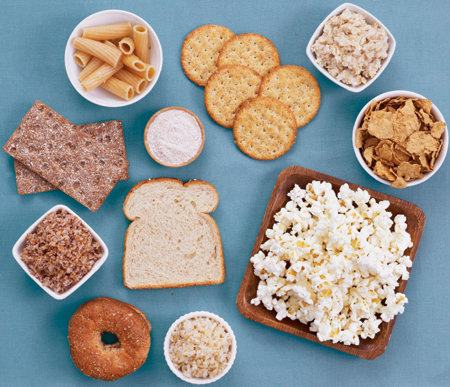
1 serving =
• 1 slice 100% whole-grain bread
• 1 whole-wheat “mini” bagel
• ½ cup cooked brown rice
• ½ cup cooked 100% whole-grain pasta
• ½ cup cooked bulgur
• ½ cup cooked oatmeal
• 1 cup 100% whole-grain ready-to-eat cereal
• 3 cups popcorn
• 5 whole-wheat crackers
• 2 rye crispbreads
• 1½ tablespoons whole-wheat flour

“My family doesn’t love whole grains.”
SARAH SORENSEN
Stay-at-Home Mom
 WHOLE-GRAIN CHALLENGE: Sarah tries to get as much healthy food into meals as she can, but neither her son Ben nor her husband Tyler are crazy about whole grains. Her small family loves pizza and Asian food, but it’s tricky to incorporate whole grains into those. Sarah likes to cook, but nap time is her only window for doing it.
WHOLE-GRAIN CHALLENGE: Sarah tries to get as much healthy food into meals as she can, but neither her son Ben nor her husband Tyler are crazy about whole grains. Her small family loves pizza and Asian food, but it’s tricky to incorporate whole grains into those. Sarah likes to cook, but nap time is her only window for doing it.
OUR ADVICE
▪ Try white whole-wheat bread and other white whole-wheat products. This isn’t a bait-and-switch gimmick; white whole-wheat flour is made from an albino variety of wheat that contains all the nutrients of its darker counterpart. Bread is the most common product made from it, but you can also find crackers and baking mixes.
▪ Cook in bulk. Make whole-grain salads in advance, chill, and enjoy for easy, quick-to-pack lunches. Try recipes with lots of herbs and vegetables, like Chicken Tabbouleh with Tahini Drizzle. Substitute leftover shrimp or stir in rotisserie chicken to vary the flavor.
▪ Make a whole-grain bed for Asian dishes. Boil-in-bag brown rice is a fast partner for stir-fries. Or try 100% buckwheat soba noodles, which cook in less than 10 minutes. Other quick options are bulgur (cracked wheat) and 100% whole-wheat couscous, ready in minutes and great with saucy curries or stir-fries.
▪ Make whole-wheat pizza crust from either whole-wheat flour or white whole-wheat flour. Either way, once you add toppings, the whole-graininess is barely detectable. Make a big batch, and freeze in one-pizza quantities.
▪ Trade in your crackers for whole-grain options. Try reduced-fat Triscuits or Wheat Thins—an easy lunch with chicken salad, packable for Tyler.
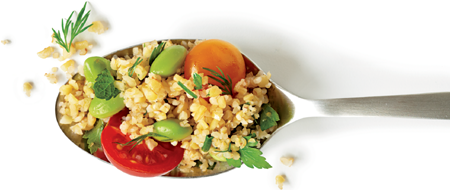
EXPERT TIP: Consider Crispy Options

“I’m really into crispbread—a thick, hearty cracker that can stand up to whatever you put on it. They’re only 40 calories per serving, and they’re positively vibrant with whole grains and fiber. I treat them as I would a bagel, with a sliced hard-cooked egg, a sprinkle of salt and pepper, and a drizzle of olive oil.”
–Allison Fishman, 12HH coach and author of You Can Trust a Skinny Cook
MOST OF US KNOW THAT GRAINS ARE GOOD FOR US but have difficulty naming more than two or three. Here’s an A-Z guide to fifteen of the most versatile—from amaranth to wheat berries.
AMARANTH

This tiny ancient grain (it’s about the size of a poppy seed) was once a sacred food of the Aztecs. It has a slightly peppery, molasses-like flavor with a faint nuttiness and pleasingly crunchy texture.
WAYS TO ENJOY: It’s good as a thickener in soups because when cooked, it has a slightly gelatinous texture. Toss amaranth or amaranth flour into breads, muffins, and pancakes.
BARLEY

Barley, best known as an ingredient in beer and soup, is a great source of fiber: ½ cup offers more than 15 grams. Most barley is pearled to remove some of the bran, so it’s not technically a whole grain. Dehulled barley is considered whole because only the hull (not the bran layer) is removed.
WAYS TO ENJOY: Since barley is so starchy, it can be treated just like Arborio rice for risottto. With its neutral flavor and ability to readily absorb flavors, it’s a chameleon among grains. Add cooked barley to soups and stews or use as a base for pilafs or cold salads.
BROWN RICE

Brown rice is the unrefined version of white rice. Other whole-grain options include the exotic red, purple, and black rices. Wild rice is also a whole grain, even though it’s not technically a rice—it’s harvested from wild aquatic water grasses.
WAYS TO ENJOY: Reach for these whole-grain rices instead of white rice when making stir-fries, casseroles, soups, and salads.
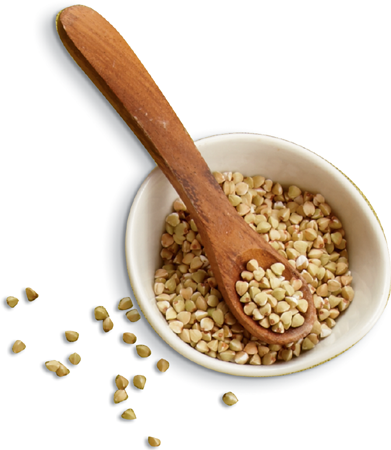
Despite its name, buckwheat isn’t technically wheat or even a grain at all. It’s a seed related to rhubarb. The whole form minus the hull is known as groats. When dry roasted or toasted, it’s called kasha, the Russian name for cereal.
WAYS TO ENJOY: Try roasted buckwheat grains (kasha) for a hot breakfast cereal or as the base for vegetable stuffing. Buckwheat grits make for a great whole-grain polenta. Use buckwheat flour to make hearty whole-grain pancakes and waffles.
BULGUR

Bulgur, familiar to many of us through the Middle Eastern dishes tabbouleh and kibbeh, is wheat that has been steamed whole, dried, then cracked.
WAYS TO ENJOY: Bulgur comes in three grinds—fine (#1), medium (#2), and coarse (#3). Fine and medium bulgurs are used for tabbouleh and kibbeh, and the coarse is good in pilafs and other rice-like dishes. Try Bulgur with Dried Cranberries.
FARRO
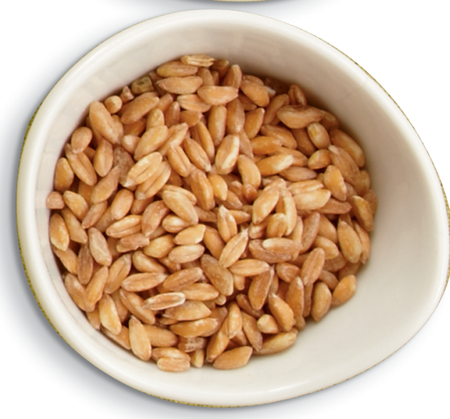
This ancient strain of wheat once fueled the Roman legions. Look for whole farro instead of “pearled” to get more whole-grain goodness.
WAYS TO ENJOY: Farro’s hearty flavor pairs well with mushrooms, sausage, beans, olives, and vegetables of all kinds, whether it’s cooked like a risotto (like our Farro Risotto with Mushrooms) or served cold in salads.
FREEKEH

Dating back to the ancient Middle East, freekeh is a roasted wheat that is harvested young when the grain is still green, soft, and full of moisture. Look for it in Middle Eastern markets and large supermarkets.
WAYS TO ENJOY: Similar to bulgur, farro, and spelt, freekeh can be used to make deliciously woodsy pilafs and other rice-like dishes. It pairs well with smoky flavors, such as smoked paprika and cumin, or Middle Eastern ingredients like mint and toasted pine nuts. The smokiness of freekeh makes it an ideal base for vegetarian burgers.

Poor millet once was dismissed as bird seed, which is where most of it turns up in the United States, but now it’s finding a new audience due to its whole-grain status and heirloom pedigree. This small, round, yellow grain is a staple in Africa and Asia.
WAYS TO ENJOY: You can toss toasted millet in salads and baked goods for a nutty crunch, or simmer and serve it with Parmesan and herbs as a side dish similar to polenta.
KAMUT® BERRIES

It’s a primitive high-protein variety of wheat and takes its name from the ancient Egyptian word for wheat. Kamut berries are about twice the size of wheat berries but are similar in flavor and texture.
WAYS TO ENJOY: Use whole Kamut berries in salads, pilafs, soups, and stews. Try Kamut pasta or couscous as a base for a veggie-studded sauce.
OATS

Oats are unique among grains because they almost never have the bran or germ removed. Virtually all forms, even quick-cooking varieties and instant, are whole grains.
WAYS TO ENJOY: A steaming bowl of oatmeal is a classic breakfast; if you prefer a chewier, nuttier texture, consider steel-cut oats, also called Irish or Scottish oats. They can also be added to salads (like Waldorf Salad with Steel-Cut Oats). Try adding rolled oats to baked goods for added texture and nutrition.
QUINOA
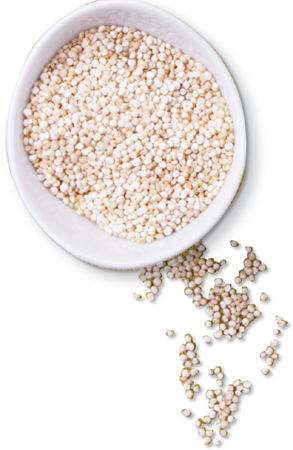
These tiny grains have a mild, sweet flavor with a unique texture that’s both fluffy and slightly crunchy.
WAYS TO ENJOY: Most quinoa needs to be rinsed to remove the natural coating called saponins, a bitter substance that protects the plant in the wild. It goes well with all kinds of vegetables, herbs, dried fruits, and nuts. Try Quinoa with Roasted Garlic, Tomato, and Spinach.

Rye is most commonly seen as flour but is also available as whole rye berries. Rye berries are a lot like wheat berries—chewy and neutral in flavor, they hold their shape when cooked.
WAYS TO ENJOY: Rye berries can be added to breads, or rolled rye can be quickly cooked for a tasty breakfast cereal. When buying rye bread, look for “whole rye” on the label to make sure it’s whole grain.
SPELT
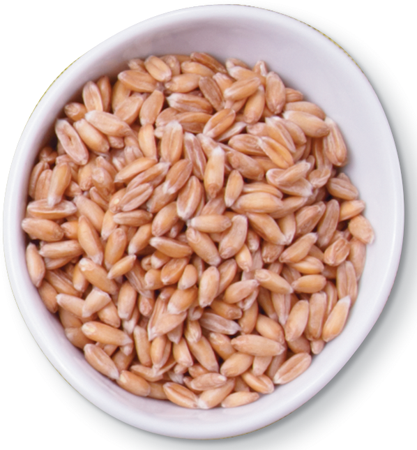
Another primitive form of wheat similar to Kamut berries, spelt is a good source of fiber and is higher in protein yet lower in gluten than durum wheat.
WAYS TO ENJOY: Spelt takes longer to cook than other grains, although the kernels can be soaked overnight to shorten cook time. Try cooked spelt berries as a hot cereal with dried fruit and maple syrup, or use as a foundation for hearty salads.
WHEAT BERRIES
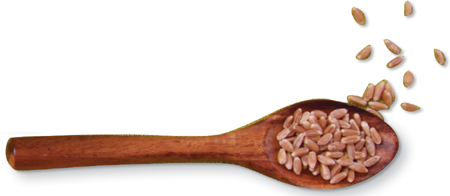
Wheat berries are the whole-grain kernels of wheat with only the inedible hull removed.
WAYS TO ENJOY: They take about an hour to cook but are worth the wait. Try as a main-dish salad tossed with beans and roasted vegetables or stirred into oatmeal as a chewy contrast to oats.
TEFF

The world’s tiniest grain, teff is believed to have originated in Ethiopia thousands of years ago. The grain’s name comes from teffa, meaning “lost” in Amharic. Teff can be ivory, light tan, brown, red, or purple.
WAYS TO ENJOY: Whole teff can be cooked like polenta and used to thicken soups, stews, and casseroles. Substitute teff flour for part of the all-purpose flour in baked goods.
WHOLE GRAINS MAY SEEM INTIMIDATING, but they’re extremely easy to prepare. If you can boil water, you can cook whole grains. The cooking method is essentially the same for all of them, except forbulgur, which has been precooked, and couscous, which is a quick-cooking pasta. Here’s our guide:

▪ When cooking grains, bring them to a boil, lower the heat, cover the pot with a tight-fitting lid, and then cook until the liquid is absorbed. Most whole grains can be cooked just like rice with the standard ratio of two parts liquid to one part grain, although sturdier grains like spelt, wheat berries, steel-cut oats, Kamut berries, and rye berries are cooked at a ratio of four parts liquid to one part grain.
▪ If the grains are sticking to the bottom of the pan, turn off the heat, add a small amount of liquid, cover the pan, and let it sit for a few minutes.
Toast the grains before cooking. It helps build flavor and brings out the sweet nuttiness of the grains.
A FEW THINGS TO CONSIDER
▪ Use the right proportion of liquid. Be sure to check package directions or recipes, as too much liquid can resultin gummy grains.
▪ Try a flavorful liquid instead of water (or a combination of the two). Boost flavor with chicken stock, vegetable broth, juice, or wine.
▪ Toast the grains before cooking. A quick toasting in oil helps build flavor and brings out the sweet nuttiness of the grains.
BUYING AND STORING GRAINS
Whole grains were once tucked away on the shelves of health-food stores, but you can now find many of them at your local supermarket. Brown rice, bulgur, wild rice, barley, and oats are widely available. Some of the more exotic grains can be a little harder to find. Look for them in bulk bins or on natural food aisles. You may have to visit a specialty food store or order them online.
Keep in mind, whole grains contain oils that eventually turn rancid, so shop at stores where the turnover seems high, and buy only what you plan to use within a few months. If you have space, it’s best to refrigerate grains, but you still can’t keep them forever. You can tell if they’ve lost their freshness by their smell: Old grains, including flours, will have a stale odor.

“Anything you would serve over rice also works with quinoa.”
HEATHER JOHNSON
Advertising Agency Project Manager
 WHOLE-GRAIN CHALLENGE: Heather Johnson is not at all shy about the fact that eating three servings of whole grains a day presented a massive challenge to her. “The only experience I had with whole grains was when an ex-boyfriend made me try kasha, the hot kind,” says Heather. With some coaching and enlightening from Cooking Light’s Healthy Habits coach Allison Fishman, Heather has now tasted victory—and a whole lot of whole grains. Here’s how she did it:
WHOLE-GRAIN CHALLENGE: Heather Johnson is not at all shy about the fact that eating three servings of whole grains a day presented a massive challenge to her. “The only experience I had with whole grains was when an ex-boyfriend made me try kasha, the hot kind,” says Heather. With some coaching and enlightening from Cooking Light’s Healthy Habits coach Allison Fishman, Heather has now tasted victory—and a whole lot of whole grains. Here’s how she did it:
HER ADVICE
▪ Substitute whole grains for pasta or white rice. “I buy pasta that’s made from quinoa, which I’ve found I really love. It cooks like rice, but it tastes better—I boil it with chicken broth instead of water to give it alittle extra flavor.”
▪ Do some bread-aisle research. “Allison suggested a couple of whole-grain breads, but I discovered Aunt Mille’s (available in the Midwest). Their Indian Grain is my favorite; one slice has 22 grams of whole grains! I love toast in the morning, and if all else fails, I’ll have a sandwich at lunch, so finding an awesome whole-grain bread was my savior.”
▪ Keep corn in the freezer. “It’s a whole grain, and I absolutely love it. My husband is a meat guy, so if I’m making a meat main course, I’ll just serve up some corn on the side.”
▪ Make snacks count. “I’ve found a few snacks with whole grains that I really like: Kashi’s granola bars are really crunchy, and SunChips are a whole grain, too. I have the Harvest Cheddar kind in the cupboard, and when I’m really hungry, I think, ‘I’m going to eat my SunChips and get my whole grain in!”

Keep frozen corn on hand for a whole-grain side the whole family can enjoy.
EXPERT TIP: Rethink Your Cereal Bowl

“We often think of oatmeal as a healthy breakfast choice, but grains like quinoa and bulgur are amazingly delicious in the morning, too. Make extra when preparing whole grains for dinner and reserve an unseasoned portion for breakfast. In the morning, warm a little, and top with brown sugar, cinnamon, fruit, a splash of milk, and grated orange rind.”
–Regan Jones, RD, blogger, The Professional Palate
MAKING WHOLE GRAINS a regular part of your cooking routine can be easy and delicious. Many dishes require only simple swaps like subbing whole-wheat breadcrumbs for regular or brown rice for white. You—and your family—will never notice the difference.
“This is the only authentic-tasting fried rice recipe I have ever had,” said SoonerSinger on CookingLight.com. “It was just like take-out minus the grease!”
Almost Classic Pork Fried Rice
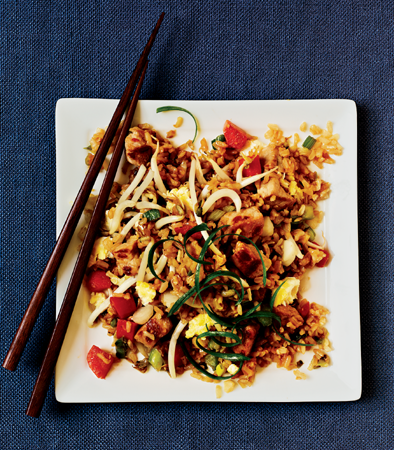
2 tablespoons peanut oil or olive oil, divided
½ teaspoon kosher salt, divided
½ pound boneless loin pork chop, cut into ½-inch pieces
½ cup chopped carrot
½ cup chopped celery
½ cup chopped green onion bottoms (white part)
2 tablespoons minced garlic
2 tablespoons minced peeled fresh ginger
3 cups cooked, chilled long-grain brown rice
1 large egg
3 tablespoons mirin (sweet rice wine)
3 tablespoons lower-sodium soy sauce
1 teaspoon dark sesame oil
¼ teaspoon freshly ground black pepper
2 cups fresh bean sprouts
¼ cup canned diced water chestnuts, rinsed and drained
1 cup sliced green onion tops
1. Heat a large skillet over medium-high heat. Add 1 tablespoon peanut oil to pan; swirl to coat. Sprinkle ⅛ teaspoon salt over pork. Add pork to pan; sauté 2 minutes or until browned on all sides. Remove pork from pan. Add carrot and celery to pan; sauté 2 minutes or until lightly browned, stirring frequently. Addcarrot mixture to pork.
2. Add remaining 1 tablespoon peanut oil to pan; swirl to coat. Add green onion bottoms, garlic, and ginger; cook 15 seconds, stirring constantly. Add rice, stirring well to coat rice with oil; cook, without stirring, 2 minutes or until edges begin to brown. Stir rice mixture, and cook, without stirring, 2 minutes or until edges begin to brown. Make a well in center of rice mixture. Add egg; stir-fry 30 seconds or until soft-scrambled, stirring constantly.
3. Return pork mixture to pan. Stir in mirin, and cook 1 minute or until mirin is absorbed. Stir in remaining ⅜ teaspoon salt, soy sauce, sesame oil, and pepper. Remove from heat, and stir in bean sprouts and water chestnuts. Sprinkle with green onion tops. Serves 4 (serving size: about 2 cups).
CALORIES 408; FAT 12.4g (sat 2.6g, mono 5.4g, poly 3.6g); PROTEIN 21g; CARB 49.3g; FIBER 6.5g; CHOL 82mg; IRON 2.4mg; SODIUM 627mg; CALC 79mg
Fontina and Parmesan Mushroom Bread Pudding

6 cups (1-inch) cubed sturdy 100% whole-wheat bread (about 12 ounces)
Cooking spray
1 teaspoon olive oil
⅓ cup chopped shallots
2 (8-ounce) packages presliced cremini mushrooms
2 tablespoons chopped fresh parsley
1 tablespoon chopped fresh thyme
¼ teaspoon salt
¼ teaspoon freshly ground black pepper
1 cup (4 ounces) shredded fontina cheese
2 tablespoons grated fresh Parmesan cheese
1½ cups 1% low-FAT milk
½ cup FAT-free, lower-sodium chicken broth
3 large eggs, lightly beaten
1. Preheat oven to 350°.
2. Place bread cubes on a jelly-roll pan; coat with cooking spray. Bake at 350° for 20 minutes or until lightly toasted, turning twice. Remove from oven; cool. Heat a large nonstick skillet over medium-high heat. Add oil to pan; swirl to coat. Add shallots and mushrooms; sauté 12 minutes or until lightly browned and moisture evaporates. Remove from heat; stir in parsley, thyme, salt, and pepper.
3. Place half of bread cubes in an 11 x 7–inch glass or ceramic baking dish coated with cooking spray. Arrange mushroom mixture evenly over bread cubes; sprinkle with ½ cup fontina and 1 tablespoon Parmesan. Top with remaining bread cubes. Combine milk, broth, and eggs, stirring with a whisk; pour over bread mixture. Gently press with back of a spoon; let stand 30 minutes. Top with remaining ½ cup fontina and remaining 1 tablespoon Parmesan.
4. Bake at 350° for 45 minutes or until set. Let stand 10 minutes. Cut into 6 squares. Serves 6 (serving size: 1 square).
CALORIES 316; FAT 12.1g (sat 5.1g, mono 3.4g, poly 0.8g); PROTEIN 18.9g; CARB 36.7g; FIBER 4.8g; CHOL 131mg; IRON 2.6mg; SODIUM 696mg; CALC 228mg
READER TIP: Change Your Method

“Brown rice was not a favorite with my kids until I changed how I cooked it. Now I combine 1 cup brown rice with 2½ cups chicken broth, 1 tablespoon oil, and seasonings like lemon rind and rosemary. I cover and bake this at 350° for 1 hour. I get the most delicious, perfect rice every time!”
—Michelle Arndt
Incorporate Whole-Wheat Pastas
PERHAPS YOU THINK WHOLE-WHEAT PASTA TASTES LIKE THE BOX it’s sold in. If so, give it another shot. The quality and taste of whole-grain pastas have improved significantly since their debut. The dark color lightens considerably when cooked, and the texture is smoother than you may think. Check out various brands until you find one you like, or try mixing half whole-grain and half refined pasta when making your favorite dishes.
Whole-Wheat Pasta with Edamame, Arugula, and Herbs

Whole-Wheat Pasta with Edamame, Arugula, and Herbs
8 ounces uncooked whole-wheat penne
2 tablespoons olive oil
1 tablespoon butter
2 cups frozen shelled edamame (green soybeans), thawed
2 cups loosely packed baby arugula
1 cup grape tomatoes, halved
¼ cup chopped fresh flat-leaf parsley
¼ cup fresh lemon juice
3 tablespoons chopped fresh basil
1 tablespoon chopped fresh thyme
½ teaspoon kosher salt
2 ounces fresh Parmigiano-Reggiano cheese, shaved
1. Cook pasta according to package directions, omitting salt and fat. Drain. Heat oil and butter in a large skillet over medium heat. Add edamame to pan; cook 2 minutes or until edamame is thoroughly heated, stirring occasionally. Combine pasta and edamame in a large bowl. Stir in arugula and next 6 ingredients, tossing well. Sprinkle each serving with cheese. Serves 4 (serving size: about 1¾ cups pasta mixture and ½ ounce cheese).
CALORIES 477; FAT 21.6g (sat 5.4g, mono 7.8g, poly 6.1g); PROTEIN 25.6g; CARB 56.6g; FIBER 13.1g; CHOL 18mg; IRON 2.8mg; SODIUM 521mg; CALC 264mg
Sesame Noodles with Broccoli
This meatless main dish uses whole-wheat spaghetti and incorporates sesame seeds in two forms: tahini (sesame seed paste) in the sauce and toasted seeds as a garnish. Tumbles on CookingLight.com said she uses half peanut butter and half tahini for the sauce, and Dlk1217 incorporates even more veggies and dials up the chile paste for more heat.
Sauce:
2 tablespoons tahini (sesame seed paste)
2 tablespoons water
2 tablespoons rice wine vinegar
2 tablespoons lower-sodium soy sauce
1½ tablespoons dark sesame oil
2 teaspoons honey
½ teaspoon salt
½ teaspoon grated peeled fresh ginger
½ teaspoon chile paste with garlic (such as sambal oelek)
2 garlic cloves, minced
Noodles:
8 ounces uncooked whole-wheat spaghetti
5 cups broccoli florets
2 cups matchstick-cut carrots
¾ cup thinly sliced green onions
⅓ cup chopped fresh cilantro
3 tablespoons sesame seeds, toasted
¼ teaspoon salt
1. To prepare sauce, combine first 10 ingredients in a small bowl; stir with a whisk.
2. To prepare noodles, cook pasta in a large pot of boiling water 5 minutes, omitting salt and fat. Add broccoli to pan, and cook 1 minute. Add carrots to pan; cook 1 minute. Drain; place in a large bowl. Sprinkle with onions and remaining ingredients. Drizzle with sauce; toss well. Serve immediately. Serves 4 (serving size: 2 cups).
CALORIES 401; FAT 13.7g (sat 2g, mono 4.9g, poly 5.9g); PROTEIN 14.9g; CARB 62.7g; FIBER 13.6g; CHOL 0mg; IRON 4.1mg; SODIUM 798mg; CALC 119mg
EXPERT TIP: Preventing Whole-Grain Boredom

“If you’re bored with whole-wheat pasta, and not ready to make the leap to millet and quinoa, try whole-grain Asian noodles instead. Japanese soba is made with buckwheat flour, and some varieties of chewy udon noodles are made with Kamut berries and spelt. You can also find brown rice Chinese vermicelli.”
—Gloria Tsang, RD, blogger, HealthCastle

2 tablespoons olive oil
2¼ cups chopped onion
¾ teaspoon kosher salt, divided
½ teaspoon freshly ground black pepper, divided
½ pound ground sirloin
8 cups chopped eggplant (about 1½ pounds)
1 tablespoon minced garlic
1 tablespoon tomato paste
½ cup red wine
1 (28-ounce) can whole tomatoes, undrained
1 tablespoon red wine vinegar
10 ounces uncooked whole-wheat fettuccine
1 tablespoon kosher salt
¼ cup small fresh basil leaves
1. Heat a Dutch oven over medium-high heat. Add oil to pan; swirl to coat. Add onion, ¼ teaspoon salt, ¼ teaspoon pepper, and beef, and cook 10 minutes or until beef is browned, stirring to crumble beef. Add eggplant, garlic, ¼ teaspoon salt, and remaining ¼ teaspoon pepper, and cook 20 minutes or until eggplant is very tender, stirring occasionally. Add tomato paste; cook 2 minutes, stirring constantly. Add wine; cook 1 minute, scraping pan to loosen browned bits. Add tomatoes, and bring to a boil. Reduce heat; simmer 10 minutes, stirring occasionally and breaking up tomatoes as necessary. Add remaining ¼ teaspoon salt and red wine vinegar.
2. Cook pasta according to package directions, adding 1 tablespoon kosher salt to cooking water. Drain. Toss pasta with sauce; sprinkle with basil leaves. Serves 6 (serving size: 1 cup sauce, about ¾ cup pasta, and 2 teaspoons basil).
CALORIES 323; FAT 7.3g (sat 1.5g, mono 4.1g, poly 1.1g); PROTEIN 17.3g; CARB 53.1g; FIBER 12.3g; CHOL 20mg; IRON 3.9mg; SODIUM 553mg; CALC 92mg
BLOGGER TIP: Whole-Grain Meal Ideas

“I make a lot of whole-grain pastas at home. If you use the right sauce you seriously can’t tell. If I have extra pasta on hand, I like to make a quick salad and throw some in. It’s a great way to add healthy carbs and feel full.”
—Nisha Singh, blogger, Honey What’s Cooking
Pasta with Fresh Tomato Sauce and Clams

Inspired by salsa cruda, or “raw sauce,” this dish features a simple and delicious combination of tomatoes, chives, garlic, and bal-samic vinegar.
5 cups chopped tomato (about 4 large)
6½ tablespoons chopped fresh chives, divided
2½ tablespoons minced garlic, divided
1 tablespoon balsamic vinegar
¾ teaspoon kosher salt
½ teaspoon black pepper
2 quarts water
1 tablespoon kosher salt
8 ounces uncooked whole-wheat spaghetti or linguine
1 tablespoon butter
1 tablespoon olive oil
16 littleneck clams
1. Combine tomato, 1⁄3 cup chives, 1 tablespoon garlic, vinegar, ¾ tea-spoon salt, and pepper in a large bowl; let stand 15 minutes. Drain mixture in a colander over a bowl, reserving liquid.
2. While tomato stands, bring 2 quarts water to a boil in a large saucepan. Add 1 tablespoon salt and pasta. Cook pasta 10 minutes or until al dente, and drain.
3. Heat butter, olive oil, and remaining 1½ tablespoons garlic in a large skillet over low heat; cook 4 minutes or until fragrant. Increase heat to medium-high. Add reserved tomato liquid, and bring to a boil; cook until reduced to ½ cup (about 6 minutes). Add clams; cover and cook 4 minutes or until shells open. Remove clams from pan, and discard any unopened shells. Add reserved tomato mixture and pasta to pan; cook 2 minutes or until thoroughly heated. Top with remaining chives. Serves 4 (serving size: about 2 cups pasta mixture, 4 clams, and about 1 teaspoon chives).
CALORIES 332; FAT 7.9g (sat 2.6g, mono 3.4g, poly 1.1g); PROTEIN 15.4g; CARB 55g; FIBER 10.2g; CHOL 20mg; IRON 8mg; SODIUM 563mg; CALC 79mg
If you’ve got delicious ripe tomatoes, you don’t need to bother seeding or peeling them. Just core them and roughly chop.
BLOGGER TIP: Consider a Buying Club

“I belong to a buying club where I can purchase grains in bulk, so different kinds of grains can be in rotation. (It’s also cheaper that way!) And when all else fails I can always sneak in some millet or buckwheat in quick breads or muffins. No one turns down a muffin, even if there’s buckwheat in it!”
—Julia Sforza, blogger, What Julia Ate
MANY WHOLE GRAINS CAN BE COOKED RISOTTO-STYLE for a delicious, comforting main dish. You won’t get quite the same silken creaminess as traditional rice risotto, but the nutty flavor and enhanced nutrition will make up for that. Try barley, farro, spelt, wheat berries, or even steel-cut oats.
Farro Risotto with Mushrooms

1 cup dried wild mushroom blend (about 1 ounce)
5½ cups Mushroom Stock
2 tablespoons extra-virgin olive oil
1½ cups uncooked farro
½ cup finely chopped onion
2 garlic cloves, minced
6 cups sliced cremini mushrooms (about 1 pound)
¾ teaspoon salt, divided
½ cup dry white wine
1 teaspoon chopped fresh thyme
¼ cup (1 ounce) grated fresh Parmigiano-Reggiano cheese
¼ cup chopped fresh flat-leaf parsley
½ teaspoon freshly ground black pepper
1. Place dried mushrooms in a bowl; cover with boiling water. Let stand 30 minutes or until tender; drain. Coarsely chop mushrooms.
2. Bring Mushroom Stock to a simmer in a small saucepan (do not boil). Keep stock warm over low heat.
3. Heat a Dutch oven over medium heat. Add oil to pan; swirl to coat. Add farro and onion; cook 5 minutes, stirring occasionally. Add garlic; cook 1 minute, stirring constantly. Add rehydrated mushrooms, cremini mushrooms, and ½ teaspoon salt; sauté 5 minutes or until cremini mushrooms are tender, stirring occasionally. Add wine and thyme; cook until liquid almost evaporates.
4. Add ½ cup stock to farro mixture; cook over medium heat 4 minutes or until liquid is nearly absorbed, stirring occasionally. Add 4½ cups stock, ½ cup at a time, stirring occasionally until each portion of stock is absorbed before adding the next (about 40 minutes total).
5. Add remaining ¼ teaspoon salt, remaining ½ cup stock, cheese, parsley, and pepper; stir until cheese melts. Serves 6 (serving size: 1 cup).
CALORIES 271; FAT 7.1g (sat 1.7g, mono 3.9g, poly 1g); PROTEIN 12.2g; CARB 43.4g; FIBER 8.5g; CHOL 4mg; IRON 1.8mg; SODIUM 378mg; CALC 71mg
2 cups boiling water
½ cup dried porcini mushrooms (about ½ ounce)
1 whole garlic head
1 tablespoon extra-virgin olive oil
2 cups (1-inch-thick) slices onion
2 cups (1-inch-thick) slices leek
1 pound cremini mushrooms, quartered
10 black peppercorns
4 parsley sprigs
4 thyme sprigs
1 bay leaf
¼ cup dry white wine
6½ cups water
1. Combine 2 cups boiling water and porcini mushrooms in a bowl. Cover and let stand 30 minutes or until tender. Strain through a fine sieve over a bowl; reserve 1½ cups liquid and mushrooms.
2. Cut off and discard pointed end of garlic just to expose cloves; set garlic head aside.
3. Heat a Dutch oven over medium-high heat. Add oil to pan; swirl to coat. Add onion and leek to pan, and sauté 5 minutes or until tender, stirring occasionally. Add porcini mushrooms, garlic, cremini mushrooms, and next 4 ingredients; sauté 10 minutes or until cremini mushrooms are tender, stirring occasionally. Add wine; cook until liquid evaporates (about 2 minutes). Add reserved 1½ cups mushroom liquid and 6½ cups water; bring to a boil. Reduce heat, and simmer 50 minutes. Strain through fine sieve over a bowl; discard solids. Store in an airtight container in refrigerator up to 1 week. Serves 6 (serving size: 1 cup).
CALORIES 28; FAT 2.4g (sat 0.3g, mono 1.7g, poly 0.3g); PROTEIN 0.5g; CARB 1.6g; FIBER 0.3g; CHOL 0mg; IRON 0.2mg; SODIUM 3mg; CALC 5mg
Mushroom—Brown Rice Risotto

1½ teaspoons kosher salt, divided
1 cup short-grain brown rice
½ cup dried porcini mushrooms (about ½ ounce)
3 cups hot water
2 tablespoons olive oil, divided
1 pound button or cremini mushrooms, sliced
3 cups (1-inch) cut green beans
1½ teaspoon black pepper, divided
½ cup chopped shallots
½ cup white wine
2 ounces Parmigiano-Reggiano cheese, grated (about ½ cup)
¼ cup chopped fresh flat-leaf parsley
2 tablespoons chopped fresh thyme
1. Bring a saucepan of water to a boil; add 1 teaspoon salt. Stir in rice; reduce heat, and simmer 15 minutes (rice will not be done). Drain. Set aside.
2. Place porcini in a medium bowl; add 3 cups hot water. Let stand 15 minutes. Drain through a sieve over a bowl; reserve liquid. Chop porcini.
3. Heat a large skillet over medium-high heat. Add 1 tablespoon oil to pan; swirl to coat. Add sliced fresh mushrooms; sauté 8 minutes or until moisture evaporates and mushrooms begin to brown, stirring occasionally. Stir in reserved porcini, green beans, ¼ teaspoon salt, and ¼ teaspoon black pepper; cook 2 minutes or until green beans are crisp-tender. Place mushroom mixture in a bowl; keep warm.
4. Return pan to medium-high heat. Add remaining 1 tablespoon oil to pan; swirl to coat. Add shallots; sauté 4 minutes or until tender. Add rice; cook 2 minutes, stirring occasionally. Stir in remaining ¼ teaspoon salt and ¼ teaspoon black pepper. Stir in wine; cook 2 minutes or until wine evaporates, stirring constantly. Add ½ cup reserved mushroom liquid to rice mixture; cook 3 minutes or until liquid is nearly absorbed, stirring constantly. Stir in remaining mushroom liquid, ½ cup at a time, stirring constantly until each portion is absorbed before adding the next (about 30 minutes total). Stir in mushroom mixture, cheese, and parsley; sprinkle with thyme. Serve immediately. Serves 4 (serving size: about 1¾ cups).
CALORIES 434; FAT 11.8g (sat 2.8g, mono 6.1g,poly 1.3g); PROTEIN 19.1g; CARB 60.6g; FIBER 9.1g; CHOL 9mg; IRON 6.6mg; SODIUM 534mg; CALC 180mg
BOLSTER YOUR SOUPS and stews with whole grains, including barley, brown and wild rice, and whole-grain noodles. Don’t forget that corn is considered a vegetable and a whole grain, so make a corn chowder or drop corn kernels into vegetable soups. Thick stews are delicious poured over a bowl of cooked brown rice, whole-wheat couscous, or wheat berries.
Pork and Wild Rice Soup

1 tablespoon extra-virgin olive oil, divided
1 (1-pound) pork tenderloin, trimmed and cut into ½-inch pieces
⅓ cup brown and wild rice blend
¼ cup finely chopped onion
3 garlic cloves, minced
2 serrano chiles, seeded and minced
1 cup water
1 teaspoon chopped fresh oregano
1 (32-ounce) carton FAT-free, lower-SODIUM chicken broth
1 (15-ounce) can black beans, rinsed and drained
¼ cup chopped fresh cilantro
2½ tablespoons fresh lime juice
¼ teaspoon kosher salt
¼ teaspoon freshly ground black pepper
1 sliced peeled avocado
3 tablespoons crumbled queso fresco
24 baked tortilla chips
1. Heat a Dutch oven over medium-high heat. Add 1½ teaspoons oil to pan; swirl to coat. Add pork to pan; brown pork on all sides. Remove from pan.
2. Heat remaining 1½ teaspoons oil in pan, scraping pan to loosen browned bits. Add rice, onion, garlic, and chiles; sauté 3 minutes or until onion is tender. Add pork, 1 cup water, oregano, broth, and beans; bring to a boil. Cover, reduce heat, and simmer 15 minutes or until rice is tender. Stir in cilantro, juice, salt, and pepper; simmer 2 minutes.
3. Top each serving with cheese, avocado, and chips. Serves 6 (serving size: 1⅓ cups soup, about 2 avocado slices, 1½ teaspoons cheese, and 4 chips).
CALORIES 282; FAT 12.1g (sat 2.7g, mono 6.7g, poly 1.7g); PROTEIN 21.6g; CARB 24.6g; FIBER 5.1g; CHOL 52mg; IRON 2.3mg; SODIUM 638mg; CALC 61mg
Curried Chickpea Stew with Brown Rice Pilaf
This curry hails from the Indian region of Punjab. The cardamom pods puff up to almost twice their size and float to the top, so they’re easy to find and discard before serving.

Pilaf:
1 tablespoon canola oil
1 cup finely chopped onion
1 cup uncooked brown rice
1½ teaspoon ground turmeric
3 cardamom pods, crushed
1 (3-inch) cinnamon stick
1 garlic clove, minced
1⅔ cups water
1 bay leaf
Stew:
1 tablespoon canola oil
2 cups chopped onion
1 tablespoon grated peeled fresh ginger
1 teaspoon ground cumin
1 teaspoon ground coriander
¾ teaspoon ground turmeric
¼ teaspoon ground red pepper
4 garlic cloves, minced
3 cardamom pods, crushed
1 (3-inch) cinnamon stick
2½ cups water
1 cup diced carrot
¼ teaspoon kosher salt
1 (15-ounce) can chickpeas (garbanzo beans), rinsed and drained
1 (14.5-ounce) can fire-roasted crushed tomatoes, undrained
½ cup plain FAT-free yogurt
¼ cup chopped fresh cilantro
1. To prepare pilaf, heat a large nonstick skillet over medium heat. Add 1 tablespoon oil to pan; swirl to coat. Add 1 cup onion; cook 6 minutes or until golden, stirring frequently. Add rice and next 4 ingredients, and cook 1 minute, stirring constantly. Add 1⅔ cups water and bay leaf; bring to a boil. Cover, reduce heat, and simmer 45 minutes. Let stand 5 minutes. Discard cardamom, cinnamon, and bay leaf. Keep warm.
2. To prepare stew, heat a large Dutch oven over medium-high heat. Add 1 tablespoon oil; swirl to coat. Add 2 cups onion; sauté 6 minutes or until golden. Add ginger and next 7 ingredients; cook 1 minute, stirring constantly. Add 2½ cups water, carrot, ¼ teaspoon salt, chickpeas, and tomatoes; bring to a boil. Cover, reduce heat, and simmer 20 minutes or until carrots are tender and sauce is slightly thick. Discard cardamom and cinnamon stick.
3. Place 1 cup rice mixture into each of 4 bowls; spoon 1¼ cups chickpea mixture over rice. Top each serving with 2 tablespoons yogurt and 1 tablespoon cilantro. Serves 4.
CALORIES 431; FAT 9.6g (sat 1g, mono 5.1g, poly 2.9g); PROTEIN 11.9g; CARB 77.9g; FIBER 9.6g; CHOL 1mg; IRON 3.1mg; SODIUM 626mg; CALC 121mg
Switching from refined grains to whole grains may seem like a major change, but you’ll discover that whole grains have an appealing chewy texture and help you feel satisfied and full for longer.
LOOK FOR WAYS TO SERVE a whole grain at every meal. Try rotating in some of these grain-based side dishes several nights a week instead of other starches, such as potatoes, white rice, or noodles. You can start off by mixing half white rice and half brown rice (or other whole grains) to make the transition easier.
Multigrain Pilaf with Sunflower Seeds
This recipe calls for long-cooking barley and brown rice, but if you’re in a hurry, substitute instant brown rice and quick-cooking barley. Just be sure to adjust cooking timesaccording to package directions.
4 teaspoons canola oil, divided
⅓ cup sunflower seed kernels
½ teaspoon salt, divided
2 teaspoons butter
1 cup thinly sliced leek (about 1 large)
2½ cups water
1½ cups FAT-free, lower-SODIUM chicken broth
½ cup uncooked pearl barley
½ cup brown rice blend or brown rice
½ cup dried currants
¼ cup uncooked bulgur
¼ cup chopped fresh parsley
¼ teaspoon freshly ground black pepper
1. Heat a Dutch oven over medium-high heat. Add 2 teaspoons oil, sunflower seeds, and ¼ teaspoon salt; sauté 2 minutes or until lightly browned. Remove from pan; set aside.
2. Heat pan over medium heat; add remaining 2 teaspoons oil and butter. Add leek; cook 4 minutes or until tender, stirring frequently. Add 2½ cups water and next 3 ingredients; bring to a boil. Cover, reduce heat, and simmer 35 minutes. Stir in currants and bulgur; cover and simmer 10 minutes or until grains are tender. Remove from heat; stir in remaining ¼ teaspoon salt, sunflower seeds, parsley, and pepper. Serve immediately. Serves 8 (serving size: ½ cup).
CALORIES 198; FAT 6.6g (sat 1.1g, mono 2.2g, poly 2.6g); PROTEIN 5g; CARB 32.7g; FIBER 4.9g; CHOL 3mg; IRON 1.5mg; SODIUM 266mg; CALC 26mg
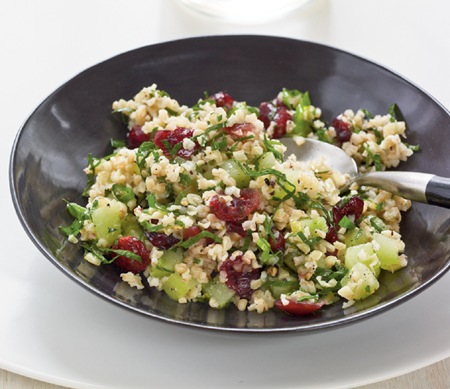
1 cup coarse-ground bulgur
2 cups boiling water
2 cups (¼-inch) cubed peeled English cucumber
1 cup dried cranberries
1 cup finely chopped fresh flat-leaf parsley
⅓ cup thinly sliced green onions
1 teaspoon grated lemon rind
⅓ cup fresh lemon juice
⅓ cup extra-virgin olive oil
¾ teaspoon kosher salt
¾ teaspoon freshly ground black pepper
1. Place bulgur in a large bowl; cover with 2 cups boiling water. Cover; let stand 30 minutes or until liquid is absorbed. Fluff with a fork. Add cucumber and remaining ingredients; toss gently to combine. Serves 8 (serving size: 1 cup).
CALORIES 197; FAT 9.6g (sat 1.3g, mono 6.7g, poly 1.2g); PROTEIN 2.7g; CARB 28.2g; FIBER 4.7g; CHOL 0mg; IRON 1.2mg; SODIUM 186mg; CALC 27mg
Quinoa with Roasted Garlic, Tomato, and Spinach

1 whole garlic head
1 tablespoon olive oil
1 tablespoon finely chopped shallots
¼ teaspoon crushed red pepper
½ cup uncooked quinoa, rinsed and drained
1 tablespoon dry white wine
1 cup fat-free, lower-sodium chicken broth
½ cup fresh baby spinach leaves
⅓ cup chopped seeded tomato (1 small)
1 tablespoon shaved fresh Parmesan cheese
¼ teaspoon salt
1. Preheat oven to 350°.
2. Remove papery skin from garlic head. Cut garlic head in half crosswise, breaking apart to separate whole cloves. Wrap half of head in foil; reserve remaining garlic for another use. Bake at 350° for 1 hour; cool 10 minutes. Separate cloves; squeeze to extract garlic pulp. Discard skins.
3. Heat a saucepan over medium heat. Add oil to pan; swirl to coat. Add shallots and red pepper to pan, and cook 1 minute. Add quinoa to pan; cook 2 minutes, stirring constantly. Add wine; cook until liquid is absorbed, stirring constantly. Add broth; bring to a boil. Cover, reduce heat, and simmer 15 minutes or until liquid is absorbed. Remove from heat; stir in garlic pulp, spinach, tomato, cheese, and salt. Serve immediately. Serves 4 (serving size: ½ cup).
CALORIES 130; FAT 5g (sat 0.7g, mono 3.1g, poly 1g); PROTEIN 4.1g; CARB 16.6g; FIBER 1.8g; CHOL 1mg; IRON 1.7mg; SODIUM 305mg; CALC 49mg
WITH A NUTTY TASTE, mild flavor, and chewy texture, whole grains are a fitting canvas for salads because they harmonize with bright, fresh flavors. You can make whole-grain salads in advance, chill, and enjoy for easy lunches and dinners.
Chicken Tabbouleh with Tahini Drizzle

ONE SURE SIGN that the bulgur is done in Chicken Tabbouleh with Tahini Drizzle is that little holes will form on top.

RINSING THE OATS in Waldorf Salad with Steel-Cut Oats removes excess starch, preventing them from becoming too sticky.
1¼ cups water
1 cup uncooked bulgur, rinsed and drained
2 tablespoons olive oil, divided
1 teaspoon kosher salt, divided
½ pound skinless, boneless chicken thighs
½ teaspoon freshly ground black pepper
3 cups chopped tomato
1 cup chopped fresh parsley
1 cup chopped fresh mint
1 cup chopped green onions
1 teaspoon minced garlic
¼ cup tahini (roasted sesame seed paste)
¼ cup plain 2% reduced-fat Greek yogurt
3 tablespoons fresh lemon juice
1 tablespoon water
1. Combine 1¼ cups water, 1 cup bulgur, 1 tablespoon olive oil, and ½ teaspoon salt in a medium saucepan; bring to a boil. Reduce heat; simmer 10 minutes (do not stir) or until liquid almost evaporates. Remove from heat; fluff with a fork. Place bulgur in a medium bowl; let stand 10 minutes.
2. Heat a large nonstick skillet over medium-high heat. Add remaining 1 tablespoon oil to pan; swirl to coat. Add chicken to pan; sprinkle with ¼ teaspoon salt and black pepper. Sauté 4 minutes on each side or until done; shred chicken. Combine bulgur, chicken, tomato, and next 4 ingredients in a large bowl; toss gently.
3. Combine remaining ¼ teaspoon salt, tahini, and remaining ingredients in a small bowl, stirring with a whisk. Drizzle over salad. Serves 4 (serving size: about 1½ cups).
CALORIES 395; FAT 18.2g (sat 3g, mono 8.8g, poly 5.1g); PROTEIN 21.5g; CARB 41g; FIBER 10.9g; CHOL 48mg; IRON 4.2mg; SODIUM 573mg; CALC 127mg
Waldorf Salad with Steel-Cut Oats
1 cup steel-cut oats, rinsed and drained
1 cup water
1 teaspoon kosher salt, divided
⅔ cup coarsely chopped walnuts
1½ teaspoons honey
⅛ teaspoon ground red pepper
3 tablespoons extra-virgin olive oil
2 tablespoons sherry vinegar
½ teaspoon freshly ground black pepper
1½ cups diced Granny Smith apple (about 1 large)
1½ cups torn radicchio
1½ cups seedless red grapes, halved
½ cup (2 ounces) crumbled blue cheese
1. Combine oats, 1 cup water, and ½ teaspoon salt in a medium saucepan; bring to a boil. Reduce heat, and simmer 7 minutes (do not stir) or until liquid almost evaporates. Remove from heat; fluff with a fork. Place oats in a medium bowl, and let stand 10 minutes.
2. Combine walnuts, honey, and red pepper in a small nonstick skillet over medium heat; cook 4 minutes or until nuts are fragrant and honey is slightly caramelized, stirring occasionally.
3. Combine remaining ½ teaspoon salt, olive oil, vinegar, and black pepper in a small bowl, stirring with a whisk. Add dressing, apple, radicchio, and grapes to oats; toss well. Place 1½ cups oat mixture on each of 4 plates, and top each serving with about 3 tablespoons walnut mixture and 2 tablespoons blue cheese. Serves 4 (serving size: 1 salad).
CALORIES 410; FAT 26.5g (sat 5.4g, mono 10.5g, poly 9.6g); PROTEIN 9g; CARB 37.9g; FIBER 5.1g; CHOL 11mg; IRON 2mg; SODIUM 683mg; CALC 106mg
Wheat Berry Salad with Raisins and Pistachios
1 cup uncooked wheat berries
¾ teaspoon salt, divided
3 tablespoons shelled pistachios
2 tablespoons olive oil
2 tablespoons fresh lemon juice
2 teaspoons honey
½ teaspoon ground coriander
½ teaspoon grated peeled fresh ginger
½ cup golden raisins
¼ cup thinly sliced green onions
2 tablespoons chopped fresh cilantro
½ cup (2 ounces) crumbled goat cheese
1. Place wheat berries and ½ teaspoon salt in a medium saucepan. Cover with water to 2 inches above wheat berries, and bring to a boil. Cover, reduce heat to medium-low, and simmer 1 hour or until tender. Drain.
2. Preheat oven to 350°.
3. Place pistachios on a baking sheet. Bake at 350° for 8 minutes, stirring once. Cool slightly, and chop.
4. Combine oil, juice, honey, coriander, ginger, and remaining ¼ teaspoon salt in a large bowl, stirring with a whisk. Add hot wheat berries and raisins; stir well to combine. Let stand 20 minutes or until cooled to room temperature.
5. Add nuts, ¼ cup green onions, and cilantro to wheat berry mixture. Transfer to a serving bowl, and sprinkle with goat cheese. Serves 6 (serving size: about ½ cup).
CALORIES 240; FAT 8.9g (sat 2.3g, mono 4.8g, poly 1.3g); PROTEIN 7.2g; CARB 36.8g; FIBER 5g; CHOL 4mg; IRON 0.7mg; SODIUM 284mg; CALC 28mg
BLOGGER TIP: Make a Grain Salad

“Instead of making your typical pasta salad, I love to use whole grains like barley, quinoa, wheat berries, farro, bulgur, or brown rice. After the grains are cooked, I add different ingredients like grilled vegetables, diced tomatoes, cucumbers, red bell pepper, radishes, canned beans, or fresh herbs. Then I toss it together with a flavorful dressing and serve as a light lunch or a side dish. As an added bonus, whole-grain salads can be made ahead and kept in the fridge for several days.”
–Kalyn Denny, blogger, Kalyn’s Kitchen
Toasted Millet and Confetti Vegetable Salad with Sesame and Soy Dressing
Toasting the millet helps bring out the nutty taste of this ancient grain. Use bulgur, whole-wheat couscous, or wheat berries if you can’t find millet.

Dressing:
3 tablespoons rice vinegar
1 tablespoon cold water
1 tablespoon lower-sodium soy sauce
1 teaspoon canola oil
½ teaspoon dark sesame oil
1 teaspoon grated peeled fresh ginger
½ teaspoon salt
1 garlic clove, minced
Salad:
1 cup uncooked millet
2 cups water
3 tablespoons chopped walnuts
1 tablespoon lower-SODIUM soy sauce
1 cup diced carrot
1 cup chopped fresh cilantro
½ cup finely chopped red bell pepper
½ cup finely chopped green bell pepper
½ cup thinly sliced green onions
1 tablespoon finely chopped seeded jalapeño pepper
1. To prepare dressing, combine first 8 ingredients in a small bowl.
2. To prepare salad, heat a medium saucepan over medium-high heat. Add millet to pan; cook 5 minutes or until golden, stirring often. Add 2 cups water; bring to a boil. Cover, reduce heat, and simmer 20 minutes. Remove from heat; let stand, covered, 10 minutes. Fluff with a fork. Cool completely.
3. Heat a small saucepan over medium-high heat. Add nuts; cook 3 minutes or until lightly toasted, stirring occasionally. Add 1 tablespoon soy sauce; cook 30 seconds, stirring constantly.
4. Cook carrot in boiling water 3 minutes or until tender. Drain, and rinse with cold water. Drain. Combine millet, carrot, cilantro, bell peppers, onions, and jalapeño in a large bowl. Drizzle dressing over millet mixture, and toss well. Top with walnuts. Serves 4 (serving size: 1¾ cups salad and about 2 teaspoons nuts).
CALORIES 238; FAT 7.3g (sat 0.8g, mono 1.7g, poly 3.9g); PROTEIN 7.3g; CARB 42.1g; FIBER 5.6g; CHOL 0mg; IRON 4.5mg; SODIUM 587mg; CALC 35mg
“Best quinoa recipe yet!” said Jugorji on CookingLight.com. “I’ve made this a few times now, and I always get requests for the recipe,” said Katmandu.
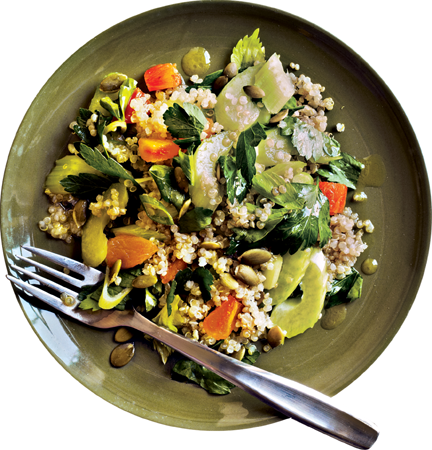
1 cup water
½ cup uncooked quinoa
¾ cup fresh parsley leaves
½ cup thinly sliced celery
½ cup thinly sliced green onions
½ cup finely chopped dried apricots
3 tablespoons fresh lemon juice
1 tablespoon olive oil
1 tablespoon honey
¼ teaspoon salt
¼ teaspoon black pepper
¼ cup unsalted pumpkinseed kernels, toasted
1. Bring 1 cup water and quinoa to a boil in a medium saucepan. Cover, reduce heat, and simmer 20 minutes or until liquid is absorbed. Spoon into a bowl, and fluff with a fork. Add parsley, celery, onions, and apricots.
2. Combine lemon juice and next 4 ingredients in a small bowl, stirring with a whisk. Add to quinoa mixture, and toss well. Top with seeds. Serves 4 (serving size: about ⅔ cup).
CALORIES 238; FAT 8.6g (sat 1.3g, mono 4.3g, poly 2.8g); PROTEIN 5.9g; CARB 35.1g; FIBER 3.6g; CHOL 0mg; IRON 4.6mg; SODIUM 172mg; CALC 47mg
Grains can be cooked in advance and kept in the refrigerator for several days or frozen in zip-top plastic freezer bags. Simply reheat in the microwave or on the stovetop with a little extra liquid.
EXPERT TIP: Step Outside Your Comfort Zone

“Experiment with extraordinary whole grains like spelt, quinoa, and Kamut berries. They cook up just like rice (only faster) and are naturally higher in PROTEIN, IRON, and hunger-fighting FIBER. Toss with seasonal veggies, beans, and vinaigrette dressing for a satisfying lunch or simple side dish.”
—Dana Angelo White, MS, RD, blogger, Healthy Eats